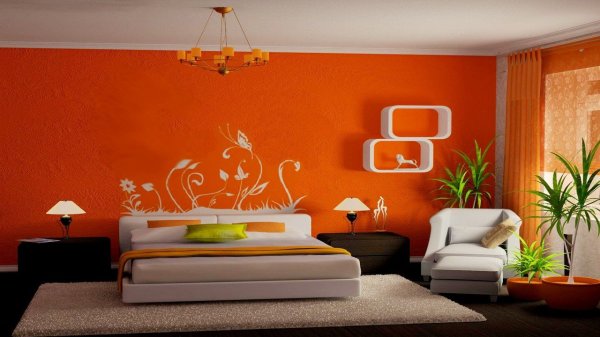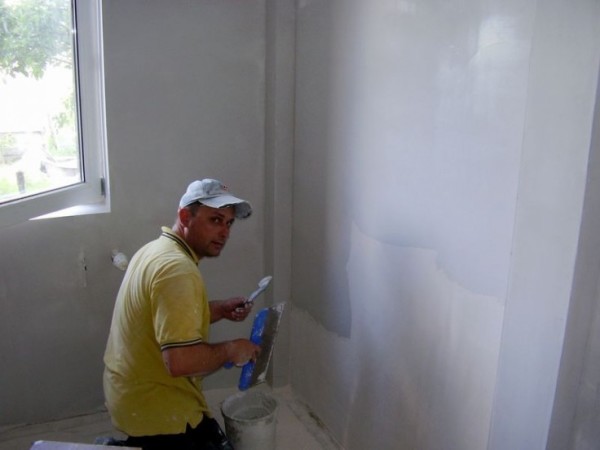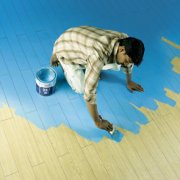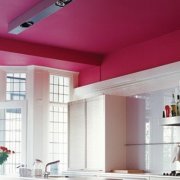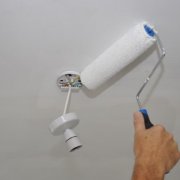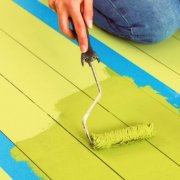Painting walls in an apartment: how and how to perform
To paint the walls in the apartment at first glance is not difficult. But just think, it becomes clear that there are plenty of questions that need to be addressed.
The coverage environment is important here. After all, the room can be wet and you must immediately decide what is better in the apartment to paint the walls. The technology of painting walls in an apartment is also quite important, because this is the key to durability. These are the issues we will consider today. Examples of painting walls in the apartment, which you can see in the video in this article and photo, will also be given.
The content of the article
Varieties of paints for interior decoration
When a decision is made to finish the interior, the question arises of how to paint the walls in the apartment. Today, a large assortment of paints for any purpose is offered. It is important not to make a mistake with the choice and choose the one that is most suitable for this case.
- Widespread use water based paints. They include water, pigments, the smallest particles of polymers. This paint is non-toxic (which is important for allergy sufferers), fireproof, waterproof, provides a breathable surface, low cost.
- The coating after staining is matte. You can get the desired shade by adding coloring pigments. In some cases, in order to obtain a beautiful, smooth surface, emulsion paint is applied in several layers.
Attention: First you need to determine the design of painting the walls in the apartment, then the environment of stay. After all, the price of moisture resistant material will be more expensive.
The most used types of paints
Design ideas can be quite different. The artistic nature of a person in his imagination may well draw the most incredible. But let's immediately look at how we can make our dreams come true and what we have on the sales market.
| Waterborne dispersion paints | Belong to the most economical look in the world of paints.
|
| Acrylic paints | They are made using acrylic resins. After drying, a solid film forms.Benefits:
|
| Water dispersible and latex paints | Dissolve with water. Their distinguishing feature is wear resistance, they are water-repellent, dry quickly. Economical, after drying they form a thin film that ensures uniformity of coating and a beautiful texture. They give the texture silky, dull, gloss. The disadvantages of these paints include their high cost; |
| Silicone paints | Industry began to produce them not so long ago. They have many advantages. They are based on silicone emulsified resins. When they dry, a protective film forms that is resistant to water. Paints for a wide range of applications; |
| Oil | These are paints that dissolve in oil.
|
| Enamel paints | They contain varnish, which provides gloss and beauty. They paint the walls (plastered and plastered), metal, wood (see. What paint is better to paint a tree: we make a choice) etc.Benefits:
|
| Alkyd Enamels | This paint for painting walls in the apartment contains alkyd resins. They dry out in contact with air, while other paints dry out because the solvent evaporates. The disadvantages of this type of paint include the presence of a specific smell, which does not immediately disappear.Benefits:
|
| Silicate paint | They are classified as mineral and are diluted with water. They include liquid glass, alkali.
|
| Adhesive paints | Similar to emulsion, only water resistant. Used in dry rooms, easy to use. Before use, they must be diluted with water according to the instructions:
|
| Decorative paints | This is a modern paint and not so long ago appeared on the sales market. With them, you can realize a creative imagination. The walls can be decorated with silk, velvet, gold, silver, stone. Everything here depends on what the designer wants. They include polymer and mineral additives that are diluted with water.Benefits:
|
Attention: Ecological paints do not contain any harmful substances. They are designed for people with allergic reactions, and are also suitable for use in children's rooms. These paints have one more name - "green paints".
Preparing the walls for painting
In an apartment, walls for painting must first of all be qualitatively prepared. This will be the guarantee of the durability of the coating. This is one of the most important stages of repair and must be approached responsibly.
So:
- The surface of the walls should be aligned so that there are no cracks, holes, voids, bulges. This increases the adhesion to the finishing materials. In order to properly prepare the room for repair, you need to free it from all that is superfluous.
- Must be removed, chandeliers, lighting fixtures, cornices. You also need to disconnect the sockets and fixtures, insulating the wires. If possible, you need to take out all the furniture from the apartment. If this is not possible, then the furniture is shifted to the center and covered with plastic wrap, then everything is wrapped with tape. To ensure that surfaces that are not to be painted remain clean, they must be sealed with masking tape.
- The time and other costs associated with preparing the walls for painting can be different depending on the year the house was built. If this is a new home, then the work can take place in the following order: 1. putty, 2. sanding the surface, 3. washing the walls, 4. primer, observing the functional characteristics of the room.
- If the house is old, the procedure will be more difficult: 1. the walls are thoroughly cleaned of the old coating 2. washed with water (to identify deficiencies) 3. if there is mold and moss, treated with special antiseptic preparations, 4. primed, 5. putty.
- Recently, structural paint has gained wide popularity. She has many advantages. This coating is universal. And if you want to learn how to work with it, everyone can. In this case, you can do without leveling the walls. You can also refine the surface of the wall by applying decorative plaster.
- Walls made from gypsum panels must be primed before painting. The same applies to gypsum plaster walls and bast fiber walls. Failure to do so will result in absorption of paint into the surface. In the room where the work is carried out, it is important to maintain the desired temperature (up to 18 degrees), to prevent drafts.
- To color the metal, protecting it from corrosion, it is advisable to use waterproof paint. During the preparatory work, the surfaces must be cleaned of the previous paint. For example, oil, alkyd, can be removed simply by rubbing the surface, but you can’t remove the water-dispersion one. To do this, use construction tools (metal brush, putty knife, etc.).
- To remove old wallpaper from the wall, you need to wet them with a damp cloth and let the water soak. Then they can be easily separated, but you can also use a spatula. They achieve smooth walls with gypsum plaster. This option is ideal for those who make repairs on their own. After all, it’s good enough to study the instructions on the package. Plaster is an environmentally friendly, completely harmless material. After the applied plaster dries, it is rubbed with sandpaper.
- The final stage is puttying. A spatula is applied to the finishing layer of the plaster, which is again rubbed with sandpaper. As a result, we get a flat surface, ready for painting or wallpapering. When the curvature of the walls is very significant, there are two ways to level them - “dry plaster” and wet.
- “Dry plastering” is plasterboard cladding. In this way, you can remove any irregularities in the walls, simplifying the process of work, and reducing costs. The disadvantage of this method is the "eating" of the free volume of the living space.
- The second way to correct the curvature of the walls is as old as the world. This is plastering. Since even small irregularities become visible after painting on the surface, no matter what method we use, the ultimate goal is a perfectly smooth surface.
Work Execution Rules
The instruction for painting consists of rules that should be followed.
So:
- Start painting from the corners, internal and external. The walls are painted from top to bottom, starting from the window illuminating the room.
- With thin brushes we paint hard-to-reach surfaces (batteries, baseboards, pipes). The baseboard is well painted with enamel varnish. If the batteries are cast iron, then it is better not to paint them, so as not to reduce heat transfer, but to close them with a decorative grill.
- So that smudges from a large amount of paint on the roller do not form on the painted surface, the roller is slightly rolled along the paint net, squeezing out excess paint. The roller should be rolled in one place two or three times so that each strip overlaps the adjacent one by 30-50 mm.
- When painting large surfaces with a roller, the wall is visually broken into small squares of 50/50 cm. In each square, first paint with vertical stripes, then overlap them with horizontal stripes. The next square should capture the previous half the length of the roller. With this method of painting, the paint lays evenly, without visible color differences. Follow the instructions!
Painting the walls in the apartment with your own hands is not a difficult task, but rather painstaking. So be patient. How much is the dye will not matter if the room is attractive.
